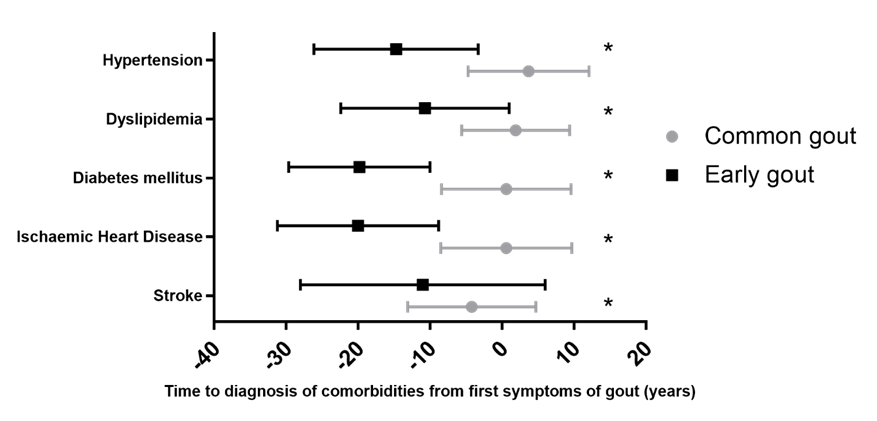Session Information
Session Type: ACR Poster Session C
Session Time: 9:00AM-11:00AM
Patients with Early Onset Gout develop Earlier Severe Joint Involvement
and Metabolic Comorbid Conditions
Background/Purpose:
Early onset gout might encompass more severe cases along with genetic defects, leading to early management as pointed out by recent guidance from the US or Europe. The objective of this study was to compare disease characteristics and comorbidities of patients suffering from gout with early onset (EOG) before the age of 40 to the general population of gouty patients.
Methods:
Patients from the cross-sectional national GOSPEL cohort having suffered from the first symptoms of gout before the age of 40 were included in the EOG group and compared to those with an onset after 40 included in the common gout (CG) group.
Results:
A total of 120 (12.2%) patients was included in the EOG group (aged 49.5 (±11.9) years) and 865 patients in the CG group (aged 64.4 (±10.1) years). Patients with EOG presented with a higher prevalence of polyarticular flares (p<0.01), but had similar proportions of patients having had at least 2 flares over the past year (p=0.16), similar prevalence of gout arthropathy (p=0.79) and tophi (p=0.53). A total of 68.9% among EOG patients were treated with urate lowering therapy (ULT) compared to 67.9% in the CG group (p=0.91), but only 19.1% in the EOG had an SUA level below 6.0mg/dL versus 29.8% in the CG group (p<0.05). More patients of the CG group where suffering from moderate to severe CKD (p<0.01). A similar proportion of patients suffered from diabetes mellitus in the EOG (12%) and CG (15.5%) groups (p=0.38) and prevalence of each item composing the metabolic syndrome did not differ significantly between groups. However, in EOG patients, cardiovascular comorbidities were present before gout onset (figure 1).
Conclusion:
In this large French cohort, EOG patients develop similar joint involvement and comorbid disorders than CG patients, but earlier in life.
Figure 1: Time to diagnosis of cardiovascular comorbidities from the first manifestations of gout in early and common gout groups. * p<0.05
To cite this abstract in AMA style:
Pascart T, Norberciak L, Ea HK, Lanz S, Lambert C, Guggenbuhl P, Liote F. Patients with Early Onset Gout Develop Earlier Severe Joint Involvement and Metabolic Comorbid Conditions [abstract]. Arthritis Rheumatol. 2017; 69 (suppl 10). https://acrabstracts.org/abstract/patients-with-early-onset-gout-develop-earlier-severe-joint-involvement-and-metabolic-comorbid-conditions/. Accessed .« Back to 2017 ACR/ARHP Annual Meeting
ACR Meeting Abstracts - https://acrabstracts.org/abstract/patients-with-early-onset-gout-develop-earlier-severe-joint-involvement-and-metabolic-comorbid-conditions/

